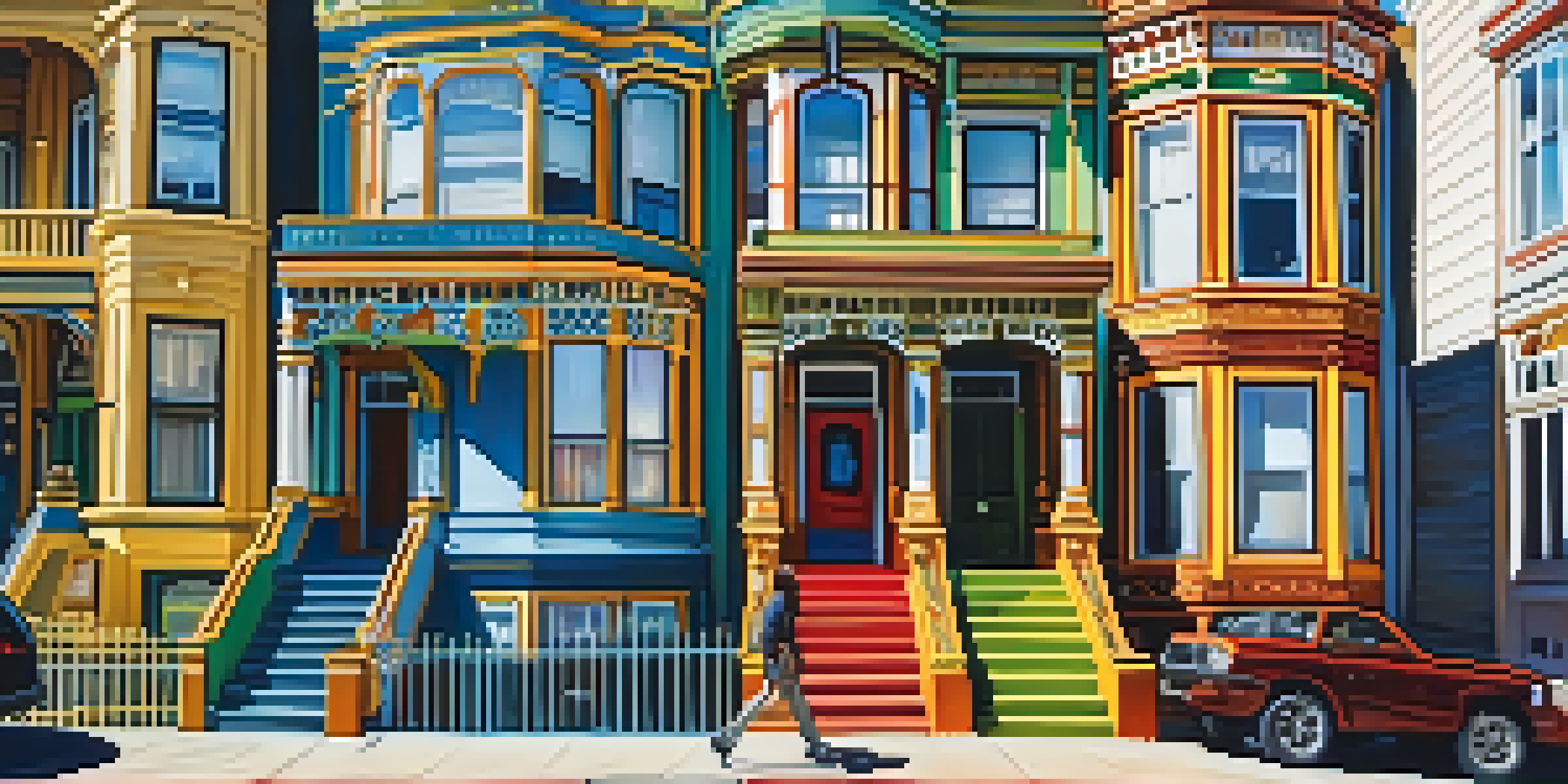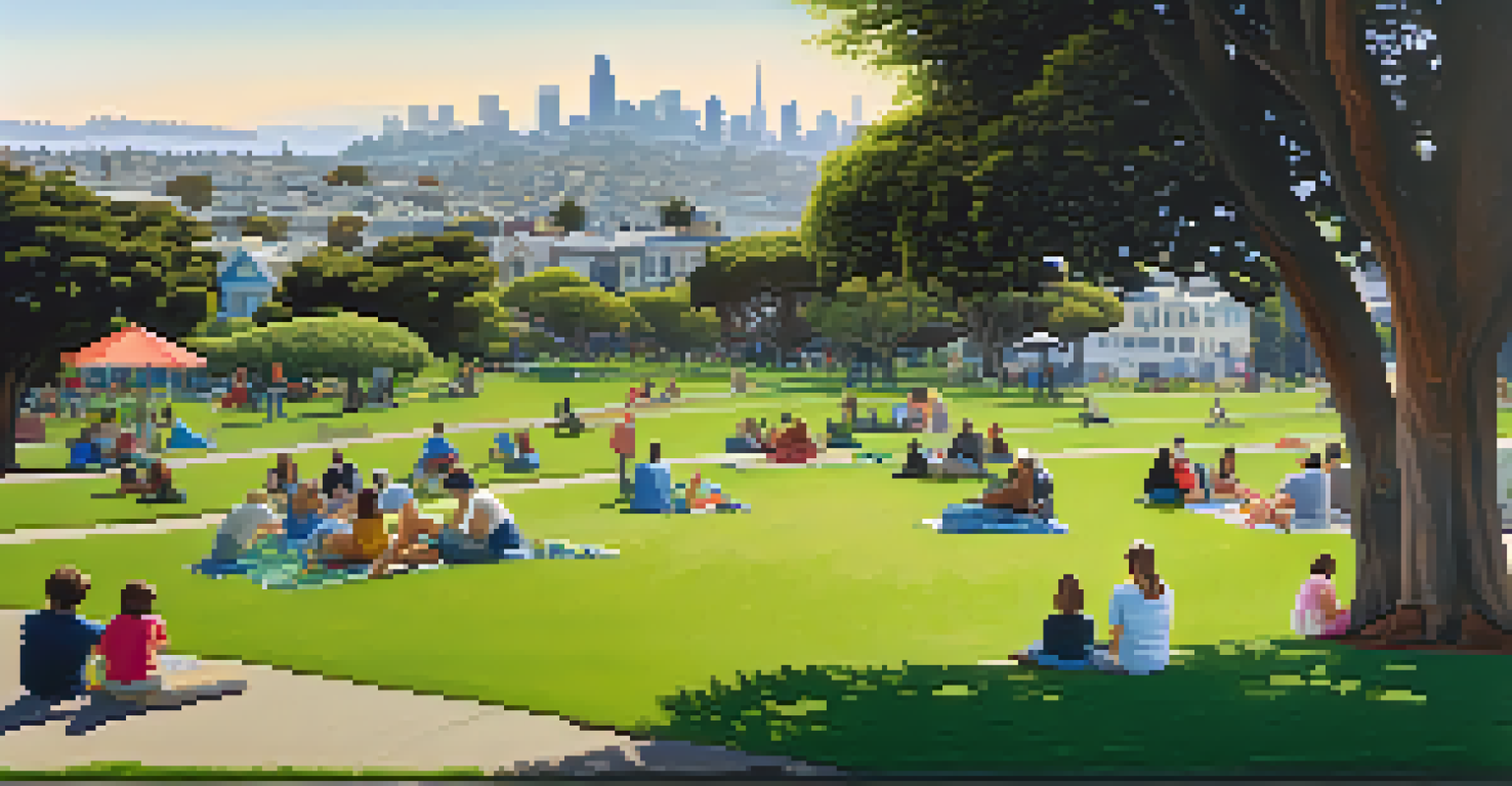Exploring the Architectural Wonders of San Francisco's Mission

A Brief History of the Mission District
The Mission District, one of San Francisco's oldest neighborhoods, has a rich tapestry of history. Founded in 1776 with the establishment of Mission San Francisco de Asís, it served as a spiritual hub for the indigenous population and Spanish settlers. Over the years, the area has transformed, reflecting waves of immigration and cultural shifts that have shaped its identity.
The city is not a concrete jungle, it is a human zoo.
In the 19th and 20th centuries, the Mission became a melting pot of cultures, with a strong influence from Mexican and Central American communities. This blend of cultures is evident in the architecture, food, and murals that adorn the streets. The neighborhood's vitality has made it a focal point for artists and activists throughout its history.
Today, the Mission is celebrated not only for its historical significance but also for its vibrant arts scene. As you stroll through its streets, you'll encounter a unique blend of old and new, from historic Victorian homes to contemporary installations. This contrast makes the Mission a fascinating place to explore.
Iconic Mission Architecture: Victorian and Edwardian Styles
One of the most striking features of the Mission District is its beautiful Victorian and Edwardian architecture. These colorful homes, often referred to as 'painted ladies,' showcase intricate details and vibrant colors that capture the essence of San Francisco's charm. The contrast between these historic homes and the modern buildings around them creates a unique visual landscape.

Victorian architecture, characterized by its ornate facades and bay windows, reflects the wealth and status of the families who built them during the Gold Rush era. In contrast, Edwardian homes, which emerged in the early 20th century, tend to be more understated but equally charming. Together, these styles tell the story of the neighborhood's evolution through the years.
Rich Historical Tapestry of the Mission
The Mission District's history, from its founding in 1776 to its current cultural vibrancy, showcases a blend of diverse influences and significant events.
As you wander through the streets, don’t forget to take a moment to appreciate the craftsmanship that went into these homes. Their architectural details, from decorative moldings to intricate doorways, provide a glimpse into the past while contributing to the Mission's vibrant present.
The Mission's Murals: A Canvas of Culture and Community
The Mission District is renowned for its stunning murals, which serve as both artistic expressions and powerful social commentaries. These vibrant artworks can be found on buildings, alleyways, and even sidewalks, reflecting the community's rich history and cultural diversity. Each mural tells a story, often inspired by local issues, traditions, or significant events.
Architecture is the learned game, correct and magnificent, of forms assembled in the light.
The murals began to flourish in the 1970s, when local artists used their talents to address social justice issues and celebrate their cultural heritage. Today, the Mission is home to over 1,000 murals, making it one of the most mural-rich neighborhoods in the world. Walking through the streets feels like traversing an open-air gallery filled with visual narratives.
Visiting the Mission’s murals is not just about appreciating the art; it’s also an opportunity to engage with the community. Many murals are created collaboratively, bringing together artists and residents to foster a sense of belonging and shared identity. This connection adds depth to the experience and highlights the power of art in shaping community.
Modern Architectural Gems in the Mission
While the Mission District is steeped in history, it also showcases a range of modern architectural gems. Contemporary buildings, such as the sleek mixed-use developments and innovative housing projects, stand in striking contrast to the historic structures. These modern designs often prioritize sustainability and community engagement, reflecting current architectural trends.
One notable example is the recent redevelopment of the Mission Market, which combines retail space with residential units. This approach not only revitalizes the area but also promotes a sense of community by providing essential services and housing in one location. Such projects illustrate the neighborhood's ability to adapt and evolve.
Architectural Diversity and Beauty
The neighborhood features a striking mix of Victorian, Edwardian, and modern architecture, reflecting both its historical roots and contemporary trends.
As you explore the Mission, keep an eye out for these modern structures that highlight the city’s forward-thinking approach to architecture. They serve as a reminder that while honoring the past, the Mission is also embracing a vibrant future.
Cultural Influences in Mission Architecture
The architecture of the Mission District is a testament to the diverse cultural influences that have shaped it over the years. From the Spanish colonial style of the original mission to the later Victorian and modern designs, each era has left its mark. This blend creates a rich architectural tapestry that reflects the neighborhood's history and its residents' identities.
The influence of Mexican culture is particularly prominent, visible in the colorful tiles, wrought iron details, and courtyards that adorn many buildings. These elements not only enhance the aesthetic appeal but also serve as a nod to the community's heritage. Walking through the streets, you can feel the vibrant spirit of Mexican culture woven into the fabric of the Mission.
Additionally, contemporary architecture continues to draw inspiration from these cultural roots, often incorporating traditional motifs into modern designs. This ongoing dialogue between past and present is what makes the Mission a unique and captivating place to explore, celebrating both its heritage and its future.
Exploring Outdoor Spaces: Parks and Public Art
In addition to its stunning architecture, the Mission District boasts several parks and outdoor spaces that provide a respite from the urban hustle. Dolores Park is perhaps the most famous, offering expansive green lawns, playgrounds, and stunning views of the city skyline. It’s a favorite spot for locals and visitors alike, making it a perfect place to unwind and appreciate the surroundings.
These parks often serve as venues for community events, festivals, and art exhibits, further enriching the neighborhood's cultural fabric. Public art installations can be found throughout these spaces, inviting visitors to engage with art in a relaxed outdoor setting. This blend of nature and creativity offers a unique way to experience the Mission.
Community Engagement Through Art
The Mission's murals and public art not only beautify the area but also serve as powerful expressions of the community's identity and social issues.
As you explore the Mission, take some time to relax in these parks and absorb the lively atmosphere. Whether it’s a casual picnic in Dolores Park or a leisurely stroll through smaller green spaces, these outdoor areas add another layer to the Mission’s architectural and cultural narrative.
Preservation Efforts: Balancing History and Modernity
With the rapid development in the Mission District, preservation efforts are crucial in maintaining the neighborhood's historical integrity. Local organizations and community members are actively working to protect the architectural heritage while accommodating new growth. This balance is essential in ensuring that the Mission remains a vibrant and authentic place.
Efforts include advocating for the preservation of historic buildings and promoting policies that prioritize affordable housing, which is increasingly threatened by gentrification. These initiatives aim to keep the Mission accessible and inclusive for all residents, honoring its rich history while adapting to contemporary needs.

As you explore the Mission, you may notice signs of these preservation efforts, from restored buildings to community murals celebrating local history. This ongoing dialogue between past and present is vital for maintaining the neighborhood's character and ensuring that its story continues to evolve.
Conclusion: The Ever-Evolving Mission District
The Mission District stands as a vibrant testament to San Francisco's diverse history and culture. Its architectural wonders, ranging from historic Victorians to modern gems, reflect the neighborhood's evolution over centuries. The art-filled streets, lively parks, and ongoing preservation efforts create a dynamic atmosphere that invites exploration.
As you immerse yourself in the Mission, you'll discover a community that celebrates its roots while embracing change. This unique blend of history and modernity is what makes the Mission a captivating destination for locals and visitors alike. Every corner tells a story, and every building adds to the rich narrative of this iconic neighborhood.
Whether you're an architecture enthusiast, a history buff, or simply looking for an engaging experience, the Mission District offers something for everyone. So, lace up your walking shoes and prepare to delve into the architectural wonders and cultural richness that make the Mission a true San Francisco gem.